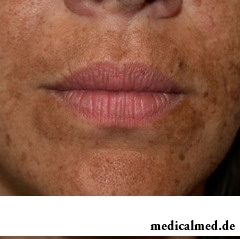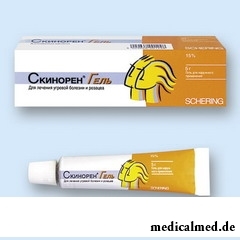





Melazma
Melazma – the acquired high-quality disturbance of a xanthopathy, locally limited  more developing in areas of the person and neck. Melazma is shown unevenly in the form of spots on skin from light brown to a dark, black shade. Spots at a melazma have accurate contours, generally are located on open sites of skin. Melazma does not affect mucous membranes. A nevus pigmentosus at a melazma is not shelled, the structure of affected areas of skin does not change. Melazma tends to clarification during the autumn and winter period. During the spring and summer period of the active sun the melazma gets brighter shade. More often women are subject to a melazma. Such type of a hyperpegmentation occurs at men extremely seldom that is caused by a hormonal etiology of this disease. Melazma can be shown both by the single centers of damage of skin, and a set of spots on all open surface of skin (a face, a neck, area of a decollete, a hand).
more developing in areas of the person and neck. Melazma is shown unevenly in the form of spots on skin from light brown to a dark, black shade. Spots at a melazma have accurate contours, generally are located on open sites of skin. Melazma does not affect mucous membranes. A nevus pigmentosus at a melazma is not shelled, the structure of affected areas of skin does not change. Melazma tends to clarification during the autumn and winter period. During the spring and summer period of the active sun the melazma gets brighter shade. More often women are subject to a melazma. Such type of a hyperpegmentation occurs at men extremely seldom that is caused by a hormonal etiology of this disease. Melazma can be shown both by the single centers of damage of skin, and a set of spots on all open surface of skin (a face, a neck, area of a decollete, a hand).
Melazma types
There are three classifications of a melazma based on clinical, histologic signs and character of a course of a disease.
So, on clinical signs (on localization of manifestations of a nevus pigmentosus) the melazma is divided into three main types:
- Painting – the main centers of damage of skin are localized in cheeks and a nose;
- Central front (tsentrofatsialny) – a nevus pigmentosus is localized in a forehead, a nose, an upper lip, a chin;
- Mandibular – spots of a melazma strike a mandible arch.
On character of a course of a disease of a melazm it is divided on:
- Passing – spots have temporality and disappear completely after the termination of influence of the factor stimulating production of melanin and development of a nevus pigmentosus (hormones, sunshine);
- Persistent – the melazma which is passing from heavier into easier form, but not passing completely.
On histologic signs distinguish:
- Epidermal melazma – increase in amount of melanin in epidermis layers. The light brown shade of spots of a melazma becomes brighter under Wood's lamp;
- Thermal melazma – increase in amount of melanin in superficial and deep layers of a derma. This pathology is characterized by spots of an ashy or bluish-gray shade. Pigmentation does not become brighter under Wood's lamp;
- The mixed melazma – this pathology is characterized by defeat of both superficial epidermal layers, and deep layers of a derma. The spots of a melazma of such genesis of usually dark brown color which are not changing under Wood's lamp.
Reasons of development of a melazma
The major factors defining emergence and development of a melazma are:
- Ultraviolet radiation – UF beams stimulate production of melanin (melanogenesis), and also growth of melanocytes (the cells of skin which are responsible for development of a pigment of melanin);
- Genetic predisposition;
- Sex;
- Disturbance of a hormonal background (reception of hormonal contraceptives, pregnancy, dysfunction of ovaries);
- Abnormal liver function, thyroid gland;
- Digestive tract diseases;
- Therapy by the photosensitizing drugs (stimulating hypersensitivity of skin to influence of ultraviolet rays);
- Disturbance of the exchange processes of an organism provoked by surplus or a lack of minerals and vitamins;
- Use of some cosmetics.
Diagnosis of a melazma
Melazma is shown by only one clinical symptom – group of accurately outlined spots on defined (more often opened) the site of skin. At diagnosis of pathological change for the choice of the correct tactics of treatment the melazma needs to be differentiated with such disturbances having similar symptomatology and external manifestations as:
- Secondary hyperpegmentation;
- Pigmental xeroderma;
- Poykilodermichesky lymphoma of skin;
- Ril's melanosis;
- Nevus.
The main diagnostic method of a melazma – Wood's lamp that allows to classify a melazma.
Melazma: treatment, main methods
Melazma  is characterized by resistance to various methods of treatment. It is necessary to remember that the melazma is some kind of reaction of an organism to the irritating factor (excessive radiation, hormonal therapy). At a melazma treatment will be ineffective without elimination of a provocative factor. At passing melazma form treatment is appointed symptomatic, directed to reduction of manifestations of a nevus pigmentosus.
is characterized by resistance to various methods of treatment. It is necessary to remember that the melazma is some kind of reaction of an organism to the irritating factor (excessive radiation, hormonal therapy). At a melazma treatment will be ineffective without elimination of a provocative factor. At passing melazma form treatment is appointed symptomatic, directed to reduction of manifestations of a nevus pigmentosus.
The main techniques of treatment of a melazma are:
- Medicamentous therapy – use of topical drugs which effect is directed to braking and inhibition of a tyrosinase (the enzyme catalyzing synthesis of melanin from tyrosine). The main side effects of topical drugs for treatment of a melazma are the secondary hyperpegmentation, dermatitis, an erythema, burning. This technique is most effective for treatment of an epidermal melazma;
- Injection methods – vnturikozhny administration of the drugs inhibiting a tyrosinase;
- Hardware treatment – use of light methods (lasers, the intensive pulsing installations). Such technique of treatment of a melazma allows to influence selectively the melanin which is contained in the pigmented cells without impact on surrounding healthy cells. Laser correction of a nevus pigmentosus assumes destruction of microsites of skin, on site which then healthy cells with normal pigmentation develop. The main lack of a technique is the increased risk of development of posttraumatic pigmentation of the processed sites of skin. At epidermal and thermal forms of a melazma treatment by hardware techniques is the most effective;
- Chemical peelings – removal of an upper layer of epidermis for the purpose of recovery of process of regeneration of skin and oppression of processes of a melanogenesis. For the purpose of correction of a nevus pigmentosus superficial and middle peelings are applied. Use of deep aggressive peeling techniques for treatment of a melazma is not justified as efficiency of a technique is small in comparison with risk of development of a secondary hyperpegmentation.
Melazma: treatment by Skinoren
At diagnosis of a melazma treatment by Skinoren is one of the most effective techniques which are applied now. Skinoren – the dermatoprotektorny means for external use having depigmenting, antibacterial, keratolytic, and also antiinflammatory effect. The main active ingredient as a part of drug is the azelaic acid making impact on hyperactive melanocytes thanks to braking of a tyrosinase. At a melazma treatment by Skinoren most effectively at early stages of development of a disease. Skinoren is issued in forms of cream and gel with various concentration of active ingredient. At a melazma treatment by Skinoren assumes a course lasting from 3 months. The main side effects of Skinoren are the hyperemia, burning, an itch. Skinoren is effective at an epidermal melazma. The Dermalny melazma will not respond to treatment this drug.
The stomach of the person not bad copes with foreign objects and without medical intervention. It is known that the gastric juice is capable to dissolve even coins.

Use of medicinal plants in therapy is urgent today, more than ever. The drugs made of curative herbs cannot on...
Section: Articles about health
Such trouble as the milkwoman's attack, at least once in life happened almost to each woman. Prevalence of a disease is explained by the fact that the causative agent of an illness belongs to the so-called opportunistic microflora living on mucous an obol...
Section: Articles about health
For anybody not a secret that our country is one of the most "drinking" in the world. At clear understanding that the use of hard alcoholic drinks – occupation extremely harmful, most of Russians belong to alcoholism with unjustified loyalty. Apparently, existence of a set of myths in which tendency to excessive libations looks nearly positively is explained by it. It is worth getting acquainted with the most widespread of similar delusions and to be convinced in them not...
Section: Articles about health
Smoking not only exerts a negative impact on the state of health of the consumer of tobacco products, but is a source з...
Section: Articles about health
So, you resolved to lose weight. And now you try to understand what to begin with: from exercise stresses or a diet? And how to make that process of weight loss did not give you an inconvenience, and, on the contrary, brought joy?...
Section: Slideshow
Not without reason doctors say that 90% of diseases begin or develop because of misoperation of intestines. Disturbance of its functions is connected with various factors among which the important place belongs to excessive "clutter" of an intestinal path. In an organism not only the remains of food, but also mass of harmful substances which we with food accepted accumulate. Accepted to accept, and about that to remove them, did not take care. And in it a problem....
Section: Articles about health
All of us, unfortunately, should face flu nearly an every year. It would seem, so frequent disease has to be study...
Section: Articles about health
An eye of the person daily experiences considerable strain. The problem of preservation of sight is for many years directly connected with a question of supply of tissues of eye enough oxygen and nutrients. This task is carried out by small vessels – capillaries. For holes...
Section: Articles about health
The concept "gluten" (differently, a gluten) combines group of the proteins which are a part of rye, barley and wheat. For most of people the use of the food stuffs containing a gluten not only is safe, but also it is very useful. Nevertheless, there is a number of myths about negative effect which allegedly gluten has on health of the person....
Section: Articles about health
Cellulitis - very widespread cosmetic shortcoming which arises approximately at 80% of women sooner or later. Emergence ег...
Section: Articles about health
Heart disease and blood vessels lead to disturbance of blood supply of bodies and fabrics that involves failures in their work, deterioration in health of the person, decrease in its working capacity and standard of living. Annually such perishes from pathologies more...
Section: Articles about health
Many parents of children at the age of 2-4 years face excessively whimsical behavior of the child. The kid exhausts constant crying and whims not only the parents, but also himself. In what the reasons of children's whims. And how to fight with them?...
Section: Slideshow
Small appetite at the child – the complaint which pediatricians should hear practically from each mother. Most often it is carried to разр...
Section: Articles about health
Extracorporal fertilization – one of the most modern methods of controlling with infertility. So far he already helped a significant amount of married couples to become happy parents. Usually to the EKO procedure difficult and very expensive, resort in those...
Section: Articles about health
Contrary to popular belief, the multiple sclerosis (MS) is not connected neither with sclerous changes of walls of vessels, nor with age forgetfulness and problems with concentration of attention. This disease has the autoimmune nature. Pathological process is expressed in degradation of nervous tissue and destruction of its enveloping layer - a myelin. Multiple damages of the central nervous system which are shown by decrease in sight, bystry fatigue, on become result of development of an illness...
Section: Articles about health
Phobia – the persuasive fear of a certain contents shown in a specific situation against the will of the person. Concepts of a phobia and fear...
Section: Articles about health
Cold – a state known to everyone which is followed by cold, cough, high temperature, a pharyngalgia. Often the first that we begin to do in hope again to become healthy – to accept medicines which are not always harmless, then...
Section: Articles about health
Some people consider what for medicine of the 21st century of secrets in the field of health of the person almost does not exist. It absolutely not so. The more answers scientists receive, the more the most difficult questions are raised for them by life. Besides, there are diseases which are not explained with science in any way of which existence people know for 100-150 years. These diseases meet not so often, but from some of them nobody is insured....
Section: Articles about health
The climax, or menopause is the normal process of the termination of genital function of the woman which is followed serious hormonal...
Section: Articles about health
Deciding to get rid of an addiction, not all imagine what effects it is necessary to face. Process of refusal of smoking causes quite essential discomfort in most of people: differences of mood, sleep disorder, fatigue, decrease физич...
Section: Articles about health
Eyes – unique body on the structure thanks to which the person obtains about 80% of information on the world around: about a form, color, size, the movement, and also many other parameters of objects or phenomena. But whether much we know about the most valuable sense body which, according to the scientist Sechenov, provides us about one thousand various feelings a minute? Let's consider 10 most surprising facts about eyes and sight....
Section: Articles about health
Antibiotics - - it is possible to call the chemical compounds suppressing growth of bacteria the break in the field of medicine which allowed to save persons...
Section: Articles about health
All diseases from nerves – in this joke a big element of truth, are said by doctors. Constant stresses lead to decrease in protective forces of an organism, and it becomes vulnerable for a set of diseases. It is wrong to think that the stress is a problem of the present. Life of people and hundred...
Section: Articles about health
For most of the working people the problem of having a snack is particularly acute enough. Sooner or later there is a question: what can be eaten quickly between a breakfast and a lunch or a lunch and leaving from service so that to receive necessary power feed, but not to overload an organism with harmful components or excess calories? We bring to your attention the list of products which quite conform to these requirements....
Section: Articles about health
All know that self-treatment is dangerous. However absolutely it is almost impossible to do without it. Rate of modern life not on...
Section: Articles about health
A lot of things depend on a condition of a backbone in a human body, a backbone - not only a support for a body, it also a receptacle for a spinal cord, that is why malfunctions with a backbone are so dangerous. To treat rachis diseases very difficult and long...
Section: Articles about health
The next flu epidemic leads to the next panic, from year to year we give in on these manipulations: professionally alarming voice of the announcer in news, reports with calculation of the died patients, an interview with people in white dressing gowns and advertizing of anti-influenza means of different degree of inefficiency. All this reminds the Hollywood movies of epidemics threatening to destroy our planet. However, there is also one more similarity to cinema: everything comes to an end well. So, how to deal with the events, not in...
Section: Articles about health
